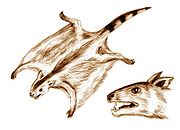- Volaticotherium
-
Volaticotherium
Rango temporal: Jurásico superior - Cretácico inferior 
Recreación artística de un volaticoterio.Clasificación científica Reino: Animalia Filo: Chordata Subfilo: Vertebrata Superclase: Tetrapoda Clase: Mammalia Orden: Volaticotheria
Meng et al., 2006Familia: Volaticotheriidae
Meng et al., 2006Género: Volaticotherium
Meng et al., 2005Nombre binomial Volaticotherium antiquus
Meng et al., 2005Volaticotherium es un mamífero fósil de hábitos planeadores que no se encuentra emparentado con ningún otro mamífero conocido actualmente.
El hallazgo de este animal supone la evidencia del mamífero planeador más antiguo conocido, con aproximadamente 70 millones de años, y estaba dotado de tal capacidad gracias a un patagio similar al de las ardillas voladoras y los galeopitecos actuales.
La dentadura sin embargo, muy distinta a la de éstos, evidencia los hábitos insectívoros de esta especie que habitó en Asia entre finales del Jurásico y principios del Cretáceo. Las evidencias fósiles de este mamífero fueron halladas en los lechos de Daohugou, en la región china de Mongolia Interior.
Sistemática
===0 Mammalia Linnaeus, 1758 - mamíferos |=O Volaticotheria Meng et al., 2006 - volaticoterios (†) | `--o Volaticotheriidae Meng et al., 2006 (†) | `-o Volaticotherium Meng et al., 2006 (†) | `-- Volaticotherium antiquus Meng et al., 2005 (†) |=> Triconodonta Osborn, 1888 - triconodontes (†) |==> Allotheria Marsh, 1880 - aloterios (†) |==> Holotheria Wible et al., 1995 - holoterios `==> Prototheria Gill, 1872 - prototerios
Referencias
- Meng, J., Hu, Y., Wang, Y., Wang, X., Li, C. (2006) A Mesozoic gliding mammal from northeastern China. Nature 444 (7121): 889-893
- Meng, J., Y.-M. Hu, Y.-Q. Wang, X.-L. Wang, y C.-K. Li. (2007) Corrigendum: A Mesozoic gliding mammal from northeastern China. Nature 446:102
- Mikko Haaramo (2007) Mikko's Phylogeny Archive. Acceso: 31 de octubre de 2007.
- Wang, X., Zhou, Z., He, H., Jin, F., Wang, Y., Zhang, J., Wang, Y., Xu, X. & Zhang, F (2005) Stratigraphy and age of the Daohugou Bed in Ningcheng, Inner Mongolia. Chinese Science Bulletin. 50(20): 2369-2376
Wikimedia foundation. 2010.
